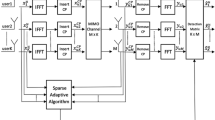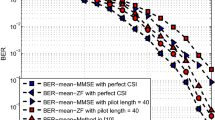Abstract
In multiuser multiple-input single-output (MISO) systems, non-linear precoder is able to achieve the theoretical sum capacity of downlink channel with perfect channel state information (CSI). However, the perfect CSI is not available at the transmitter in practical system, especially in frequency division duplex (FDD) system where the imperfect CSI is the delayed, quantized channel direction information relayed back from the receiver through a dedicated feedback channel. So the performance of conventional non-linear precoder degrades significantly. In this paper, a robust non-linear Tomlinson–Harashima precoding (THP) based on sum mean squared error (SMSE) minimization for the downlink of multiuser MISO FDD systems is proposed. The proposed precoder is robust to the channel uncertainties arising from channel delay and quantization error. Furthermore, an improved non-linear THP with channel magnitude information (CMI) consideration is introduced to compensate the instantaneous CMI shortage at the transmitter. Additionally, the computational complexity of both proposed precoders can be reduced remarkably by Cholesky factorization with symmetric permutation. Simulation results demonstrate the improvement in bit error ratio performance and illustrate the SMSE performance of the proposed algorithms compared with conventional THP with perfect CSI in the literature.










Similar content being viewed by others
References
Gesbert, D., Kountouris, M., Heath, R. W., Chae, C. B., & Salzer, T. (2007). From single-user to multiuser coommunications: Shifting the MIMO psradigm. IEEE Signal Processing Magazine, 24(5), 36–46.
Goldsmith, A., Jafar, S. A., Jindal, N., & Vishwanath, S. (2003). Capacity limits of MIMO channels. IEEE Journal on Selected Areas in Communications, 21(5), 684–702.
Spencer, Q. H., Swindlehurst, A. L., & Haardt, M. (2004). Zero-forcing methods for downlink spatial multiplexing in multi-user MIMO channels. IEEE Transactions on Signal Processing, 52, 461–471.
Schubert, M., Shi, S., Jorswieck, E. A., & Boche, H. (2005). Downlink sum-MSE transceiver optimization for linear multi-user MIMO systemsin. In Proceedings of the IEEE asilomar conference on signals, systems and computers (pp. 1424–1428).
Sadek, M., Tarighat, A., & Sayed, A. H. (2007). A leakage-based precoding scheme for downlink multi-user MIMO channels. IEEE Transactions On Wireless Communications, 6(5), 1711–1721.
Kusume, K., Joham, M., Utschick, W., & Bauch, G. (2005). Efficient Tomlinson–Harashima precoding for spatial multiplexing on flat MIMO channel. IEEE International Conference on Communications, 3, 2021–2025.
Caire, G., & Shamai(Shitz), S. (2003). On the achievable throughput of a multi-antenna Gaussian broadcast channel. IEEE Transactions on Information Theory, 43(7), 1691–1706.
Au-Yeung, C. K., & Love, D. J. (2007). On the peformance of random vector quantization limited feedback beamforming in a MISO system. IEEE Transactions on Wireless Communications, 6(2), 458–462.
Shenouda, M. B., & Davidson, T. N. (2007). Tomlinson–Harashima precoding for broadcast channels with uncertainty. IEEE Journal on Selected Areas in Communications, 25(7), 1380–1389.
Ubaidulla, P., & Chochalingman, A. (2010). Robust Tomlinson–Harashima precoders for multiuser MISO downlink with imperfect CSI. Wireless Personal Communications, 54, 53–68.
Wang, X. Z., Niu, K., He, Z. Q., Yu, G. W., & Li, H. (2010). Robust THP design with the presence of errors in CSIT acquisition. China Communications, 4, 78–86.
Castro, P. M., Joham, M., Castedo, L., & Utschick, W. (2007). Optimized CSI feedback for robust THP design. In 41st Asilomar coference on signals, systems and computers (ACSSCS).
Ubaidulla, P., & Chockalingman, A. (2009). Robust MMSE Tomlinson–Harashima precoder for multiuser MISO downlink with imperfect CSI. EURASIP journal on advances in signal processing: Special issue on multiuser MIMO transmission with limited feedback, cooperation, and coordination (vol. 2009, 13 pp).
Slim, I., Mezghani, A., & Nossek, J. A. (2011). Quantized CDI based Tomlinson Harashinma precoding for broadcast channels. In IEEE international conference on communication(ICC).
Hassibi, B., & Hochwald, B. M. (2003). How much training is needed in a multiple-antenna wireless link. IEEE Transactions on Information Theory, 49, 951–964.
Zhang, J., Health R. W., Jr., Kountouris, M., & Andrews, J. G. (2009). Mode switching for MIMO broadcast channel based on delay and channel quantization. EURASIP Journal on Advances in Signal Processing, Article ID 8052548, 15 pp.
Jindal, N. (2006). MIMO broadcast channels with finite-rate feedback. IEEE Transactions on Information Theory, 52(11), 5045–5060.
Zhang, C. H., XU, W., & Chen, M. (2009). Robust MMSE beamforming for multiuser MISO systems with limited feedback. IEEE Signal Processing Letters, 16(7), 588–591.
Golub, G. H., & Loan, C. F. V. (1996). Matrix computations (3rd ed.). Baltimore, MD: Johns Hopkins University Press.
Kusume, K., Joham, M., Utschick, W., & Bauch, G. (2007). Cholesky Factorization with symmetric permutation applied to detecting and precoding spatially multiplexed data streams. IEEE Transactions On Signal Processing, 55(6), 3089–3103.
Castañeda, M. H., Slim, I., Mezghami, A., & Nossek, J. A. (2010). Transceiverdesign multiuser MISO systems with imperfect Transmit CSI. International ITG Workshop on Smart Antennas (WSA) is a conference held on 23–24 Feb, 2010, 442–449.
Acknowledgments
The work presented in this paper has been funded in part by the National Science and Technology Major Projects under Grant No. 2011ZX03001-007-03, the Beijing Natural Science Foundation under Grant No.4102043, and co-funded by ZTE.
Author information
Authors and Affiliations
Corresponding author
Appendix
Appendix
Here we give a detailed derivation process of the expression (37).
Inserting (7) and (28) into (60), we get
Note that \(\mathbf{{S}}_{n - 1}\) is distributed in the null space of \({\hat{\mathbf{H}}}_{n - 1}\), so (61) change into
where (a) holds because \(\mathbf E _n\) is independent of \(\mathbf{A }_{n-1}\) and \(\mathbb{E } \{\mathbf{E }_{n}\}=\mathbf{0}\), it also follows from (8) and (9). From the expressions of \(\mathbf{Q}_n\) and \(\varOmega _n, SMSE_{THP}\) can be written as
For analyzing the \(SMSE_{THP}\) performance conveniently, utilizing (36), the final \(SMSE_{THP}\) expression is
Rights and permissions
About this article
Cite this article
Sun, Y., Wu, M., Guo, Q. et al. Robust Non-linear Precoder for Multiuser MISO Systems Based on Delay and Channel Quantization. Wireless Pers Commun 72, 1993–2014 (2013). https://doi.org/10.1007/s11277-013-1117-9
Published:
Issue Date:
DOI: https://doi.org/10.1007/s11277-013-1117-9




